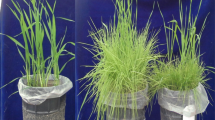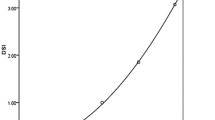Abstract
Conventional weed management systems have produced many harmful effects on weed ecology, human health and environment. Biological control of invasive weeds may be helpful to minimize these harmful effects and economic losses incurred to crops by weeds. In our earlier studies, plant antagonistic bacteria were obtained after screening a large number of rhizobacteria for production of phytotoxic substances and effects on wheat and its associated weeds under laboratory conditions. In this study, five efficient strains inhibitory to broad-leaved dock and non-inhibitory to wheat were selected and applied to broad-leaved dock co-seeded with wheat both in pot trial and chronically infested field trial. Effects of plant antagonistic bacteria on the weed and infested wheat were studied at tillering, booting and harvesting stage of wheat. The applied strains significantly inhibited the germination and growth of the weed to variable extent. Similarly, variable recovery in losses of grain and straw yield of infested wheat from 11.6 to 68 and 13 to 72.6% was obtained in pot trial while from 17.3 to 62.9 and 22.4 to 71.3% was obtained in field trial, respectively. Effects of plant antagonistic bacteria were also evident from the improvement in physiology and nutrient contents of infested wheat. This study suggests the use of these plant antagonistic bacteria to biologically control infestation of broad-leaved dock in wheat under field conditions.

Similar content being viewed by others
References
Abbas T (2017) Effect of plant antagonistic bacteria on the growth and yield of wheat (Triticum aestivum L.) and its associated weeds. PhD Dissertation. University of Agriculture, Faisalabad. Pakistan.
Alavanja MCR, Hoppin JA, Kamel F (2004) Health effects of chronic pesticide exposure: cancer and neurotoxicity. Am Rev Public Health 25:155–197
Blair A, Ritz B, Wesseling C, Freeman LB (2015) Pesticides and human health. Occup Environ Med 72(2):81–89
Charudattan R (2005) Ecological, practical and political inputs into selection of weed targets: what makes a good biological control target? Biol Control 35:183–196
Charudattan R, Dinoor A (2000) Biological control of weeds using plant pathogens: accomplishments and limitations. Crop Prot 19:691–695
Crone EE, Marler M, Pearson DE (2009) Non-target effects of broadleaf herbicide on a native perennial forb: a demographic framework for assessing and minimizing impacts. J Appl Ecol 46:673–682
Dagno K, Lahlali R, Diourte M, Jijakli MH (2012) Present status of the development of mycoherbicides against water hyacinth: successes and challenges—a review. Biotechnol Agron Soc Environ 16(3):360–368
De Prado R, Osuna MD, Fischer AJ (2004) Resistance to ACCase inhibitor herbicides in a green foxtail (Setaria viridis) biotype in Europe. Weed Sci 52:506–512
Duncan DB (1955) Multiple range and multiple F-test. Biometrics 11:1–42
Ghorbani R, Leifert C, Seel W (2005) Biological control of weeds with antagonistic plant pathogens. Adv Agron 86:191–225
Guyton KZ, Loomis D, Grosse Y, El Ghissassi F, Benbrahim-Tallaa L, Guha N, Scoccianti C, Mattok H, Straif K (2015) Carcinogenicity of tetrachlorvinphos, parathion, malathion, diazinone and glyphosate. The LANCET Oncol 16(5):490–491
Harris PA, Stahlman PW (1996) Soil bacteria as selective biological control agents of winter annual grass weeds in winter Triticum aestivum. Appl Soil Ecol 3:275–281
Heap IM (2013) The International survey of herbicide resistant weeds Available from: http://www.weedscience.org/
Hoddle MS (2004) Restoring balance: using exotic species to control invasive exotic species. Conserv Biol 18:38–49
Horwath W, Elliott LF, Lynch JM (1998) Influence of soil quality on the function of inhibitory rhizobacteria. Letters in Appl Microbil 26:87–92
Kennedy AC, Stubbs TL (2007) Management effects on the incidence of jointed goatgrass inhibitory rhizobacteria. Biol Control 40:213–221
Kennedy AC, Johnson BN, Stubbs TL (2001) Host range of a deleterious rhizobacterium for biological control of downy brome. Weed Sci 49:792–797
Kennedy AC, Elliott LF, Young FL, Douglas CL (1991) Rhizobacteria suppressive to the weed downy brome (Bromus tectorum L.) Soil Sci Soc Am J 55:722–727
King E, Ward M, Raney D (1954) Two simple media for the demonstration of pycyanin and Xuorescein. J Lab Clin Med 44:301–307
Kremer RJ, Kennedy AC (1996) Rhizobacteria as biological control agents of weeds. Weed Technol 10(3):601–609
Leiss KA (2001) Phenotic plasticity and genetic differentiation in ruderal and agricultural populations of the weed Senecio vulgaris L.: implication for its biological control. Eur Weed Res Soc Newsletter 76:15–17
Mejri D, Gamalero E, Tombolini R, Musso C, Massa N, Berta G, Souissi T (2010) Biological control of great brome (Bromus diandrus) in durum wheat (Triticum durum): specificity, physiological traits and impact on plant growth and root rchitecture of fluorescent pseudomonad strain X33d. Biol Control 55:561–572
Owen A, Zdor R (2001) Effect of cyanogenic rhizobacteria on the growth of velvetleaf (Abutilon theophrasti) and corn (Zea mays L.) in autoclaved soil and the influence of supplemental glycine. Soil Biol Biochem 33:801–809
Pimentel D (2005) Environmental and economic costs of the application of pesticides primarily in the United States. Environ Dev Sustain 7:229–252
Scheepens PC, Muller-Scharer S, Kempenaar C (2001) Opportunities for biological weed control in Europe. Biol Control 46:127–138
Smith ME, Lewandrowski JK, Uri ND (2000) Agricultural chemical residues as a source of risk. Rev Agric Econ 22:313–325
Solaimalai A, Ramesh RT, Baskar M (2004) Pesticides and environment. In: Kumar A (ed) Environmental contamination and bioreclamation. APH Publishing Corporation, New Delhi, pp 351–394
Steel RGD, Torrie JH, Dicky DA (1997) Principles and procedures of statistics—a biometrical approach, 3rd edn. McGraw Hill Book International Co., Singapore
Sturz AV, Christie BR (2003) Beneficial microbial allelopathies in the root zone: the management of soil quality and plant disease with rhizobacteria. Soil Till Res 72:107–123
Vargas RDF, O’Hara GW (2006) Isolation and characterization of rhizosphere bacteria with potential for biological control of weeds in vineyards. J Appl Microbiol 100:946–954
Watson WA, Litovitz TL, Klein-Schwartz W, Rodgers GC Jr, Youniss J, Reid N, Rouse WG, Rembert RS, Borys D (2004) 2003 annual report of the American Association of Poison Control Centers Toxic Exposure Surveillance System. Am J Emerg Med 22:335–404
Wolf B (1982) The comprehensive system of leaf analysis and its use for diagnosing crop nutrient status. Commun Soil Sci Plant Anal 13:1035–1059
Zahir ZA, Arshad M, Frankenberger WT Jr (2004) Plant growth promoting rhizobacteria: applications and perspectives in agriculture. Adv Agron 81:97–168
Zdor RE, Alexander CM, Kremer RJ (2005) Weed suppression by deleterious rhizobacteria is affected by soil type and formulation. Commun Soil Sci Plant Anal 36:1289–1299
Zeller SL, Brandl H, Schmid B (2007) Host-plant selectivity of rhizobacteria in a crop/weed model system. PLoS One 2(9):846–858
Acknowledgements
Authors are grateful to the Higher Education Commission of Pakistan for their financial support through Indigenous PhD Fellowship Program for 5000 scholars during this research work.
Author information
Authors and Affiliations
Corresponding author
Ethics declarations
Conflict of interest
The authors declare that they have no conflict of interest.
Additional information
Responsible editor: Philippe Garrigues
Rights and permissions
About this article
Cite this article
Abbas, T., Zahir, Z.A., Naveed, M. et al. Biological control of broad-leaved dock infestation in wheat using plant antagonistic bacteria under field conditions. Environ Sci Pollut Res 24, 14934–14944 (2017). https://doi.org/10.1007/s11356-017-9144-9
Received:
Accepted:
Published:
Issue Date:
DOI: https://doi.org/10.1007/s11356-017-9144-9




